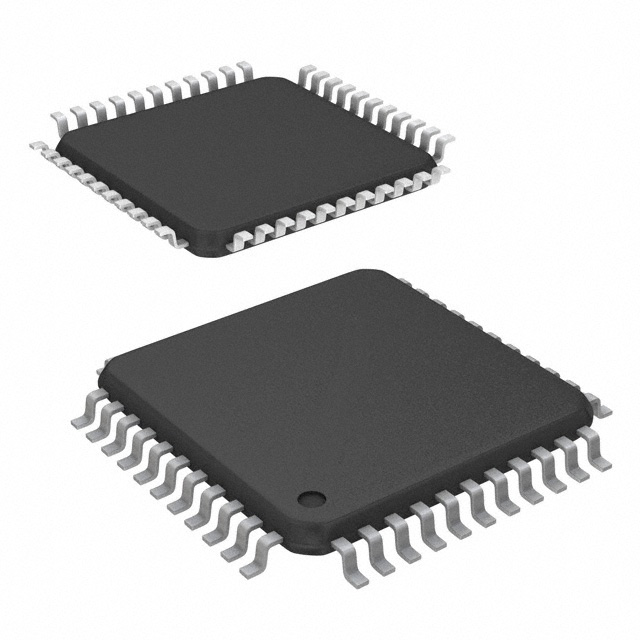Xem thông số kỹ thuật để biết chi tiết sản phẩm.

ATMEGA323-8AC
Product Overview
Category
ATMEGA323-8AC belongs to the category of microcontrollers.
Use
It is commonly used in various electronic applications that require a microcontroller for processing and controlling functions.
Characteristics
- High-performance microcontroller with advanced features
- Low power consumption
- Wide operating voltage range
- Integrated peripherals for enhanced functionality
- Robust and reliable design
Package
ATMEGA323-8AC is available in a compact and durable package, suitable for easy integration into electronic circuits.
Essence
The essence of ATMEGA323-8AC lies in its ability to provide efficient processing and control capabilities in a wide range of electronic applications.
Packaging/Quantity
ATMEGA323-8AC is typically packaged in trays or reels, with varying quantities depending on the manufacturer's specifications.
Specifications
- Microcontroller architecture: AVR
- Operating voltage: 2.7V to 5.5V
- Flash memory: 32KB
- RAM: 2KB
- EEPROM: 1KB
- Number of I/O pins: 32
- Timers/counters: 3
- Analog-to-digital converter (ADC): 8 channels
- Communication interfaces: UART, SPI, I2C
- Clock speed: Up to 8MHz
Detailed Pin Configuration
The ATMEGA323-8AC microcontroller has a total of 40 pins, each serving a specific purpose. The pin configuration is as follows:
- Pins 1 to 20: Digital I/O pins (PA0 to PA7, PB0 to PB7)
- Pins 21 to 28: Analog input pins (ADC0 to ADC7)
- Pins 29 to 32: Ground (GND)
- Pins 33 to 36: Power supply (VCC)
- Pin 37: Reset (RESET)
- Pin 38: Crystal oscillator input (XTAL1)
- Pin 39: Crystal oscillator output (XTAL2)
- Pin 40: Voltage reference (AREF)
Functional Features
1. High-performance Processing
ATMEGA323-8AC offers a powerful processing capability, allowing for efficient execution of complex tasks.
2. Integrated Peripherals
The microcontroller is equipped with various integrated peripherals such as timers/counters, ADC, and communication interfaces, enabling seamless integration with external devices.
3. Low Power Consumption
ATMEGA323-8AC is designed to operate at low power levels, making it suitable for battery-powered applications.
4. Robust Design
With its robust design, the microcontroller can withstand harsh environmental conditions, ensuring reliable operation in demanding applications.
Advantages and Disadvantages
Advantages
- High-performance processing capability
- Integrated peripherals enhance functionality
- Low power consumption extends battery life
- Robust design ensures reliability
Disadvantages
- Limited memory capacity compared to some other microcontrollers
- Relatively higher cost compared to lower-end microcontrollers
Working Principles
ATMEGA323-8AC operates based on the AVR architecture, which utilizes a Harvard architecture with separate program and data memories. It executes instructions stored in the flash memory and interacts with external devices through its I/O pins and integrated peripherals.
Detailed Application Field Plans
ATMEGA323-8AC finds application in various fields, including but not limited to: - Industrial automation - Consumer electronics - Automotive systems - Medical devices - Internet of Things (IoT) applications
Detailed and Complete Alternative Models
Some alternative models that offer similar functionalities to ATMEGA323-8AC include: - ATMEGA16A - ATMEGA32A - ATMEGA64A - ATMEGA128A
These models provide varying memory capacities and additional features, allowing users to choose the most suitable microcontroller for their specific application requirements.
In conclusion, ATMEGA323-8AC is a high-performance microcontroller with integrated peripherals, low power consumption, and a robust design. It finds applications in various fields and has alternative models with different specifications to cater to diverse needs.
Liệt kê 10 câu hỏi và câu trả lời thường gặp liên quan đến ứng dụng ATMEGA323-8AC trong giải pháp kỹ thuật
Sure! Here are 10 common questions and answers related to the application of ATMEGA323-8AC in technical solutions:
Q: What is ATMEGA323-8AC? A: ATMEGA323-8AC is a microcontroller from the AVR family, manufactured by Atmel. It has 32KB of flash memory, 2KB of SRAM, and various peripherals.
Q: What are the key features of ATMEGA323-8AC? A: Some key features include 32 general-purpose I/O pins, 8-channel 10-bit ADC, UART, SPI, I2C, timers/counters, and PWM outputs.
Q: What are the typical applications of ATMEGA323-8AC? A: ATMEGA323-8AC is commonly used in industrial automation, home automation, robotics, consumer electronics, and other embedded systems.
Q: How can I program ATMEGA323-8AC? A: You can program ATMEGA323-8AC using various programming languages like C or assembly. Popular development tools like Atmel Studio or Arduino IDE can be used.
Q: Can I use ATMEGA323-8AC for real-time applications? A: Yes, ATMEGA323-8AC can be used for real-time applications as it has built-in timers/counters and interrupt capabilities.
Q: What is the operating voltage range of ATMEGA323-8AC? A: The operating voltage range is typically 2.7V to 5.5V, making it compatible with a wide range of power supply options.
Q: Does ATMEGA323-8AC support communication protocols like I2C and SPI? A: Yes, ATMEGA323-8AC has built-in hardware support for I2C and SPI communication protocols.
Q: Can I interface ATMEGA323-8AC with external devices? A: Yes, ATMEGA323-8AC has multiple GPIO pins that can be used to interface with external devices like sensors, displays, motors, etc.
Q: Is ATMEGA323-8AC suitable for low-power applications? A: Yes, ATMEGA323-8AC offers various power-saving modes and features like sleep mode, idle mode, and power reduction registers.
Q: Are there any development boards available for ATMEGA323-8AC? A: Yes, there are development boards specifically designed for ATMEGA323-8AC, such as Arduino Mega or custom-made boards using the microcontroller.
Please note that these answers are general and may vary depending on specific requirements and implementations.

